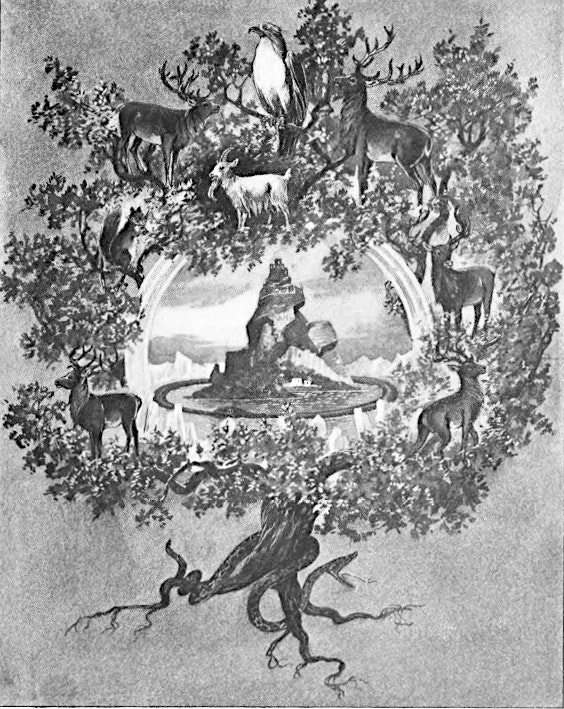With its branches in the heavens and its roots in the underworld, the Cosmic Tree is a common feature of religions and mythologies around the globe. Stories of such trees have been recorded in the Americas, Asia, India, Africa, the Middle East, and Europe — and while the species and specifics may vary from place to place, one thing almost always hold true: the Cosmic Tree is central to the structure of the universe.
The sacred Norse Yggdrasil — says E. O. James in his classic archaeological study The Tree of Life (1966) — is perhaps “the Cosmic tree par excellence”. A giant ash tree described in both the Poetic Edda and Snorri Sturluson’s 13th-century Prose Edda, Yggdrasil stands at the absolute center of the Norse cosmos. Its roots connect it with the Nine Worlds, and it is tended by the three Norns Urðr, Verðandi, and Skuld (powerful female figures who roughly correspond to the three Fates of Greece), who water it from the magical Well of Urðr.
Probably the most famous story associated with Yggdrasil concerns Odin, who in order to gain the wisdom of the runes and the favor of the Norns hung upside down “nine long nights, / wounded with a spear […] / on that tree of which no man knows where its roots run”.
In Norse cosmology, there is no more important entity than Yggdrasil. When it dies, the myths tell us, the whole world of the gods dies with it. Nearly every Norse text that mentions Yggdrasil emphasizes that the tree is not only sacred, it is mortal, and sorely in need of compassion and protection. Odin, in the Poetic Edda, says that Yggdrasil “suffers agony / more than men know, a stag nibbles it above, but at its side it’s decaying, and Níðhöggr [a malicious serpent or dragon] rends it beneath”. Elsewhere in the Eddas, we’re told that countless dangerous serpents slither below Yggdrasil; a squirrel is constantly scurrying up and down its trunk, bringing news; and Gullinkambi, one of three roosters whose crowing will signal Ragnarök (the Twilight of the Gods), nests in Yggdrasil’s upper canopy like a sentry.
The deep origins of Yggdrasil are mysterious. The English scholar Hilda Ellis Davidson has plausibly suggested its mythology developed from ancient north Eurasian shamanic traditions, according to which a tree rising through the center of the world was thought to act as a sort of ladder to descend into the underworld or ascend into the heavens. Such a concept is familiar in many cultures, from the Hungarian égig érő fa (topless tree), to the Vedic Indian sacred fig tree called the ashvattha (which Krishna, in the Upanishads, says has no beginning or end), to its Buddhist descendant, the Bodhi, under which Gautama reached enlightenment.
Certainly, the tradition of holy trees has found an enduring role in Scandinavian culture. Warden trees, known as tuntre in Norwegian and vårdträd in Swedish, are still planted in centrals place on many farms today. These trees, if well taken care of, are thought to bring good luck to the farm and the people who live there. It’s a belief not so far removed from ancient lore — which held that the court of the gods was “kept beneath a great ash and it was there they meted out justice”.

In the words of the Old Norse poem Völuspá, Yggdrasil is “the friend of the clear sky,”[5] so tall that its crown is above the clouds. Its heights are snow-capped like the tallest mountains, and “the dews that fall in the dales” slide off of its leaves.[6] Hávamál adds that the tree is “windy,” surrounded by frequent, fierce winds at its heights. “No one knows where its roots run,”[7] because they stretch all the way down to the underworld, which no one (except shamans) can see before he or she dies. The gods hold their daily council at the tree.[8]
According to the poem Grímnismál, Yggdrasil has three main roots: one planted in Midgard, the world of mankind; one in Jotunheim, the world of the giants; and one in Hel, the underworld.[12] Völuspá mentions only one well beneath the tree: the Well of Urd (Urðarbrunnr, “Well of Fate“).[13]
1 thought on “Yggdrasil”